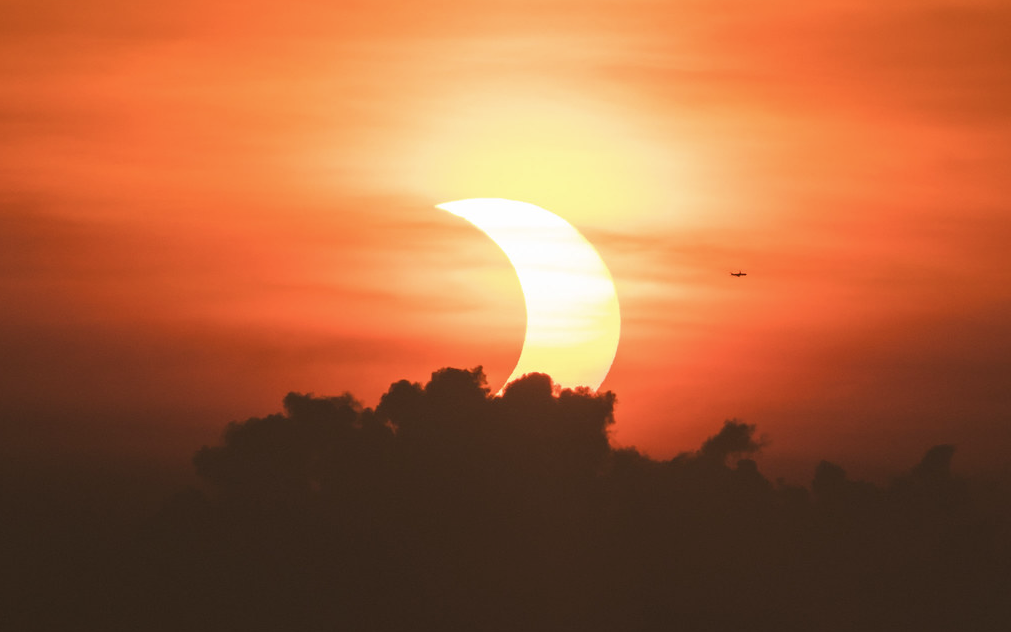A remote solar eclipse ends the final season of 2025.
Subtle astronomical events can still produce memorable scenes, hidden away in distant locales. Such a spectacle goes down on Sunday/Monday, September 21st/22nd, with a partial solar eclipse. Although the eclipse only skims the southernmost portion of the South Pacific, viewers along the eastern coast of Australia, Antarctica and all of New Zealand will see an unforgettable sight, as a partially-eclipsed Sun rises out of the sea.
The eclipse marks the end of the final eclipse season for 2025, which began two weeks ago with a total lunar eclipse. The Moon’s dark inner shadow juuuust misses the Earth on Sunday night into Monday morning, passing 250 miles over the South Pole region. The shadow is actually antumbral, meaning the Moon is too small (30’06” in apparent size, versus Sol's 31’52”) to cover the Sun. Even if the inner shadow of the Moon were to touch down on the surface of the Earth Sunday night, it would only produce an annular eclipse.
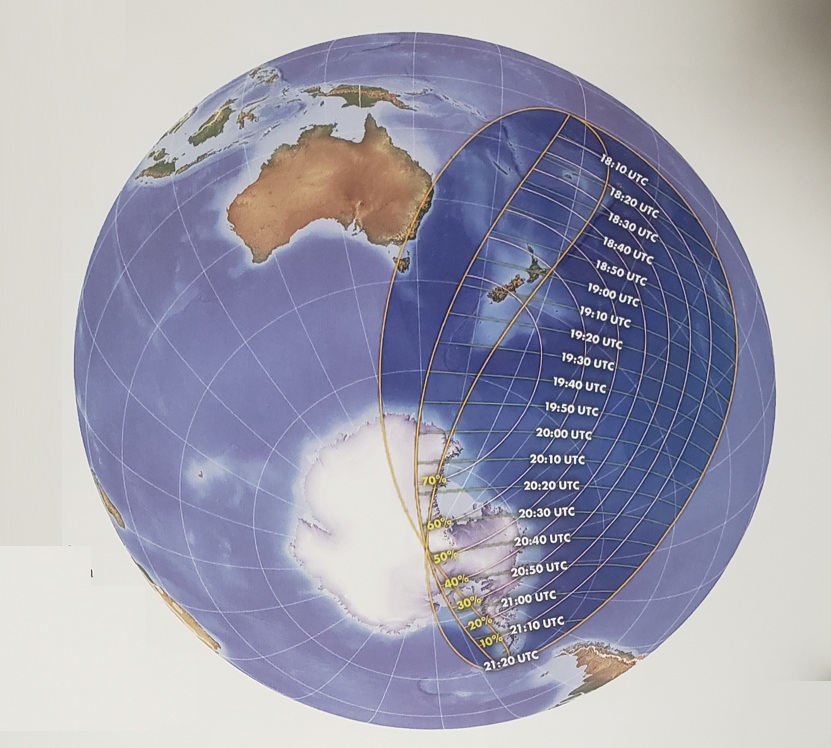 A map showing maximum eclipse times and percentages across the region. Credit: adapted from *Atlas of Solar Eclipses 2020 to 2045* by Michael Zeiler and Michael Bakich.
A map showing maximum eclipse times and percentages across the region. Credit: adapted from *Atlas of Solar Eclipses 2020 to 2045* by Michael Zeiler and Michael Bakich.
This comes at just 23 hours before the southward equinox on Saturday, September 21st. During the eclipse, the declination of the Sun is still only a scant 22’ north of the equator. The Moon goes on to reach apogee 405,551 kilometers from the Earth just five days later on September 26th.
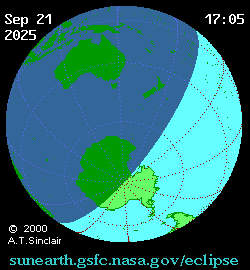 Sunday night's partial solar eclipse, skimming the South Pacific. NASA/GSFC/A.T. Sinclair.
Sunday night's partial solar eclipse, skimming the South Pacific. NASA/GSFC/A.T. Sinclair.
The entire eclipse lasts 4 hours, 24 minutes and 1 second in duration, from the first touchdown of the Moon’s outer shadow near the island of Fuji at 17:29 Universal Time (UT) until final departure near in Antarctic coast of the Weddell Sea at 21:53 UT. Remote Young Island between New Zealand and Antarctica will see the maximum obscuration for the Sun at 85%, though most populated areas will see less.
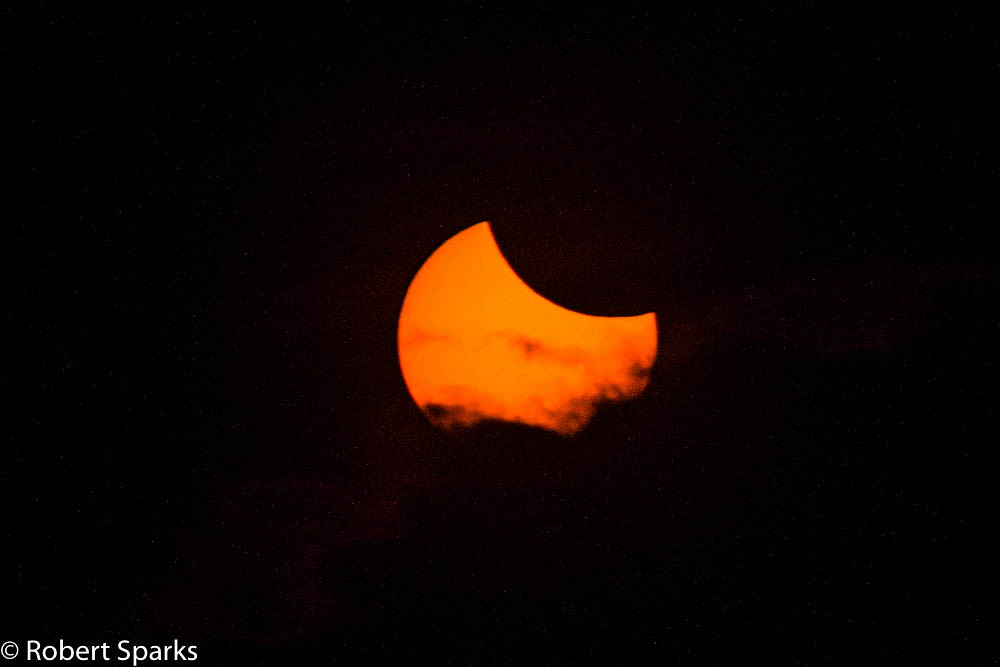 A partial eclipse rise from Lava Lava Hawaii in 2016. Credit: Robert Sparks.
A partial eclipse rise from Lava Lava Hawaii in 2016. Credit: Robert Sparks.
Though it’s partial only, this solar eclipse should give observers a great shark fin view, as the fat dazzling horn of the Sun seems to rise from the sea at sunrise. Sydney, Australia and Hobart, Tasmania will see a 2% and 4% eclipsed Sun at sunrise respectively, while McMurdo station in Antarctica will see the Sun 68% eclipsed, 4 degrees in the sky above the horizon. Note that locally, sunrise for these locations occurs on the morning of the 22nd.
The southern tip of the South Island in New Zealand may get the very best view, with a 20% and growing ‘shark fin’ hook at sunrise.
“Not having seen a solar eclipse of saros 154, I thought it was worthwhile to travel” eclipse chaser Patrick Poitevin told *Universe Today*. “Solar eclipses have always been my excuse to travel. This will be my 56th solar eclipse.” This time around, Patrick opted for a slim 9% eclipsed sunrise from the island of Tahiti in French Polynesia. He notes he was also on the nearby island of Tubuai for a partial solar eclipse in 1993 (am officially jealous).
Viewing and Safety
Be sure to take proper safety precautions during all phases of the eclipse; 15% is still dangerously bright. Use glasses rated ISO 12312-2 meant to specifically look at the Sun, along with filters for optics specifically meant for solar viewing that affix snugly to the front aperture of the instrument. NASA has a great in-depth site on eclipse safety.
Watch for lattice work or gaps in tree leaves to act as mini- pinhole ‘solar projectors,’ dappling walls and sidewalks with hundreds of little crescent Suns.
Though the entire event transpires in full daylight, you may just be able to nab -4th magnitude Venus nearby, 26 degrees northwest of the Sun.
Tales of the Saros
This eclipse is member 7 of the 71 solar eclipses in saros series 154, which runs from 1917 to 3179 AD. This is a relatively young saros at just over a century old, and it won’t produce its first annular solar eclipse until an Earth-skimming event over the southern Indian Ocean one saros from now on October 3rd, 2043.
We haven’t as of yet seen any live webcasts for the eclipse crop up, though we’ll note if any surface along with images, views from space etc. We’ll be posting these as @AstroDave on Bluesky before and after the eclipse.
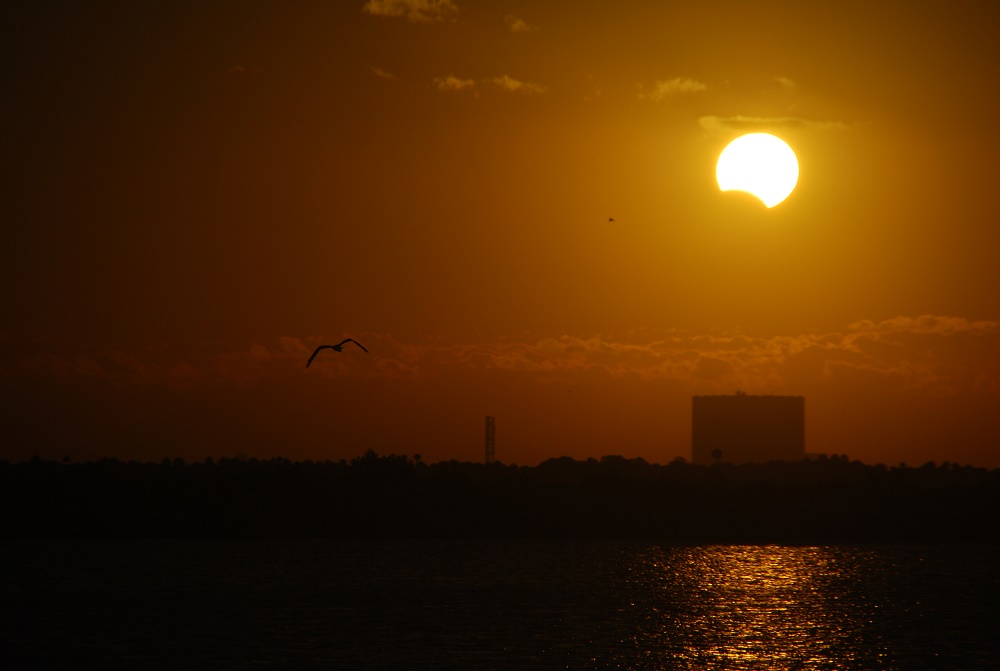 Eclipse-rise, over the Vehicle Assembly Building (VAB) at the Kennedy Space Center on November 3rd, 2013. Credit: Dave Dickinson.
Eclipse-rise, over the Vehicle Assembly Building (VAB) at the Kennedy Space Center on November 3rd, 2013. Credit: Dave Dickinson.
When’s the next total? Well, the good news is, 2026 does indeed feature a total solar eclipse, with totality crossing Iceland the North Atlantic and northern Spain less than a year from now on August 12th, 2026.
Don’t miss the final eclipse of the year, either in person or online.
 Universe Today
Universe Today
